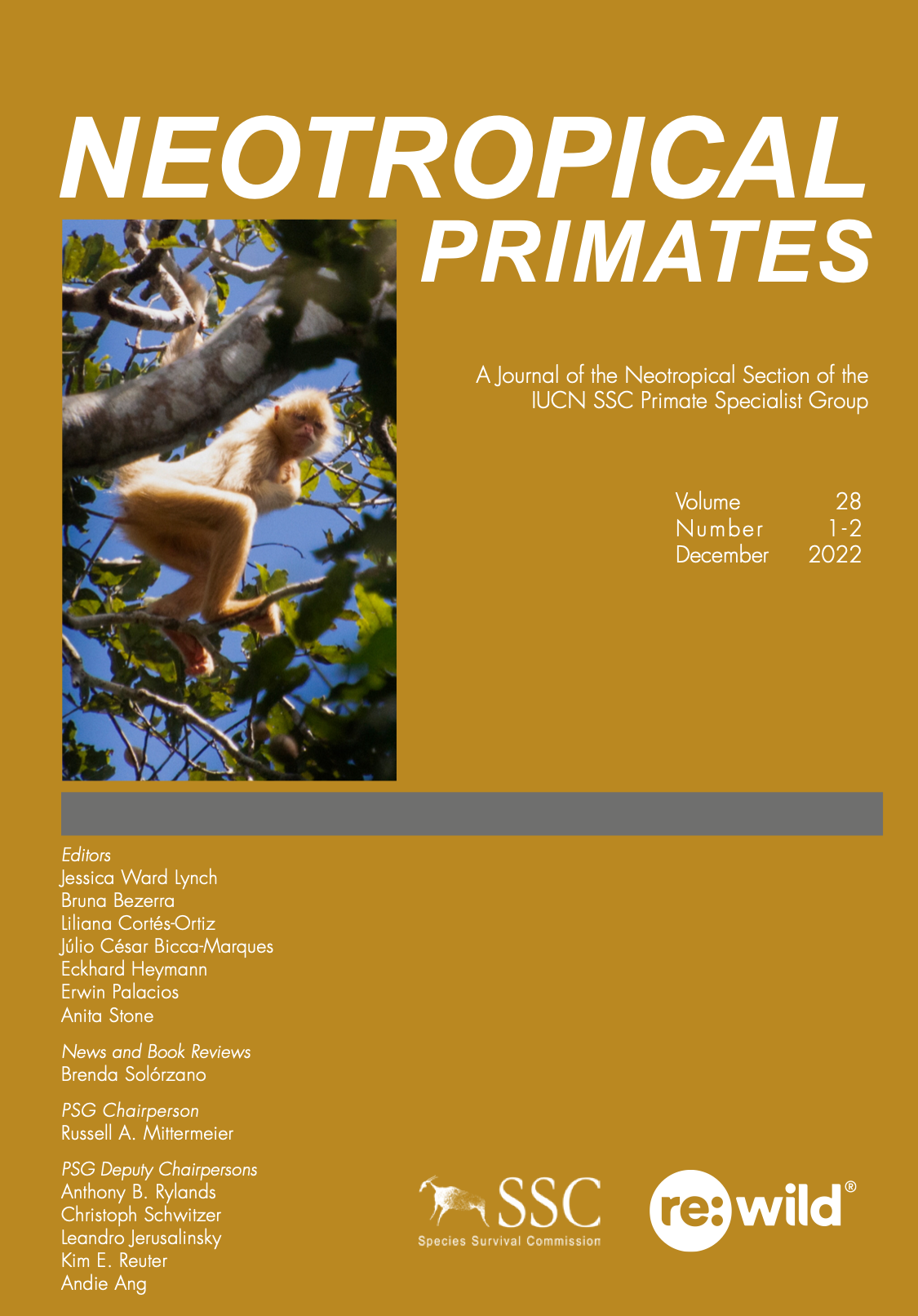Primates at the newly established Camaquiri Conservation Initiative, Limon, Costa Rica
DOI:
https://doi.org/10.62015/np.2022.v28.225Keywords:
Costa Rica, conservation, Ateles, Alouatta, CebusAbstract
In Costa Rica, Geoffroy’s spider monkey (Ateles geoffroyi ornatus) is classified as ‘Endangered’ according to the IUCN Red List of Threatened Species. Given the threats it faces, this spider monkey was included in the most recent ‘Top 25 Endangered Primate Species’ list published by the IUCN (Schwitzer et al. 2019). The newly established Camaquiri Conservation Initiative (CCI) site, located on 200 ha in northeastern Costa Rica in Caribbean lowland rain forest, harbors a population of these monkeys that has yet to be studied. The population size of these primates and the extent to which their habitat may be fragmented is unknown. We conducted transect surveys of spider monkeys, mantled howling monkeys (Alouatta palliata) and Panamanian white-faced capuchins (Cebus imitator) at Camaquiri in 2019, 2020 and 2021 over the course of 13.5 days, covering 32 km total, to establish baseline information important for this new reserve’s conservation management plan, and for providing a rough estimate of the number of study subjects available for potential researchers. We recorded, minimally, 10 different individual spider monkeys in at least one community, at least three different howling monkey groups and at least one capuchin monkey group resident at CCI. Given that large patches of healthy, intact tropical forest are rarely conserved in Central America, Camaquiri provides an opportunity to conserve endangered primate species and to contribute to our knowledge of these animals. Additionally, its proximity to other field stations provides opportunities for studies of patch connectivity, habitat quality and other characteristics that influence primate populations in this region.
References
Anderson, D. R., Laake, J. L., Crain, B.R. and Burnham K.P. 1979. Guidelines for line transect sampling of biological populations. Journal of Wildlife Management 43: 70–78.
Benchimol, M. and Peres, C. A. 2014. Predicting primate local extinctions within “real‐world” forest fragments: a pan‐neotropical analysis. Am. J. Primatol. 76(3): 289–302.
Bezanson, M., McNamara, A. 2019. The what and where of primate field research may be failing primate conservation. Evolutionary Anthropology 28: 166–178.
Chapman, C. A. and Onderdonk, D. A. 1998. Forests without primates: primate/plant codependency. Am. J. Primatol. 45: 127–141.
Daily, G. C., Ceballos, G., Pacheco, J., Suzán, G. and Sánchez-Azofeifa, A. 2003. Countryside biogeography of neotropical mammals: conservation opportunities in agricultural landscapes of Costa Rica. Conservation Biology 17(6): 1814–1826.
Dunn, J. C., Shedden-González, A., Cristóbal-Azkarate, J., Cortés-Ortiz, L., Rodríguez-Luna, E. and Knapp, L. A. 2014. Limited genetic diversity in the critically endangered Mexican howler monkey (Alouatta palliata mexicana) in the Selva Zoque, Mexico. Primates 55(2): 155–160.
Elphick, C. S. 2008. How you count counts: the importance of methods research in applied ecology. Journal of Applied Ecology 45: 1313–1320.
Garber, P. A. 2019. Distinguished primatologist address—moving from advocacy to activism: changing views of primate field research and conservation over the past 40 years. Am. J. Primatol. 81(9): e23052.
IUCN. 2022. The IUCN Red List of Threatened Species. Version 2021-3. International Union for the Conservation of Nature (IUCN), Gland. Website: www.iucnredlist.org. Accessed 19 June 2022.
Luckett, E., Danforth, E., Linsenbardt, K. and Pruetz, J. D. 2004. Planted trees as corridors for primates at El Zota Biological Field Station, Costa Rica. Neotrop. Primates 12: 143–146.
Nowak, K., Barnett, A. A. and Matsuda, I. 2019. Primates in Flooded Habitats: Ecology and Conservation. Cam- bridge University Press, Cambridge, UK.
Paterson, J. D. 2010. Primate Behavior. Waveland Press, Inc., Long Grove.
Peres, C. A., 1997. Effects of habitat quality and hunting pressure on arboreal folivore densities in neotropical forests: a case study of howler monkeys (Alouatta spp.). Folia Primatol. 68(3–5): 199–222.
Pruetz, J. D. and LaDuke, T. C. 2001. New field site: preliminary census of primates at El Zota Biological Field Station, Costa Rica. Neotrop. Primates 9(1): 22–23.
Pruetz, J. D. and Leasor, H. C. 2002. Densities of primate species in forest fragments at La Suerte Biological Field Station, Costa Rica. Neotrop. Primates 10: 4–9.
Ramos-Luna, J., Alvarez-Velazquez, M. F., Chapman, C. A. and Serio-Silva, J. C. 2022. Anomalous pigmentation in American primates: review and first record of a leucistic black howler monkey in southeast Mexico. Folia Primatol. 1: 1–9.
Schwitzer, C., Mittermeier, R. A., Rylands, A. B., Chioz- za, F., Williamson, E. A., Byler, D., Wich, S., Humle, T., Johnson, C., Mynott, H. and McCabe, G. 2019. Prima- tes in peril: the world’s 25 most endangered primates 2018–2020. IUCN SSC Primate Specialist Group, International Primatological Society, Global Wildlife Conservation, and Bristol Zoological Society: Washington, DC.
Wackerly, N. 2016. Positional behavior of black-handed spider monkeys (Ateles geoffroyi), including a one-armed individual, at El Zota Biological Field Station, Costa Rica. MA thesis, Iowa State University, Iowa.

Downloads
Published
Issue
Section
License

This work is licensed under a Creative Commons Attribution-NonCommercial-ShareAlike 4.0 International License.


